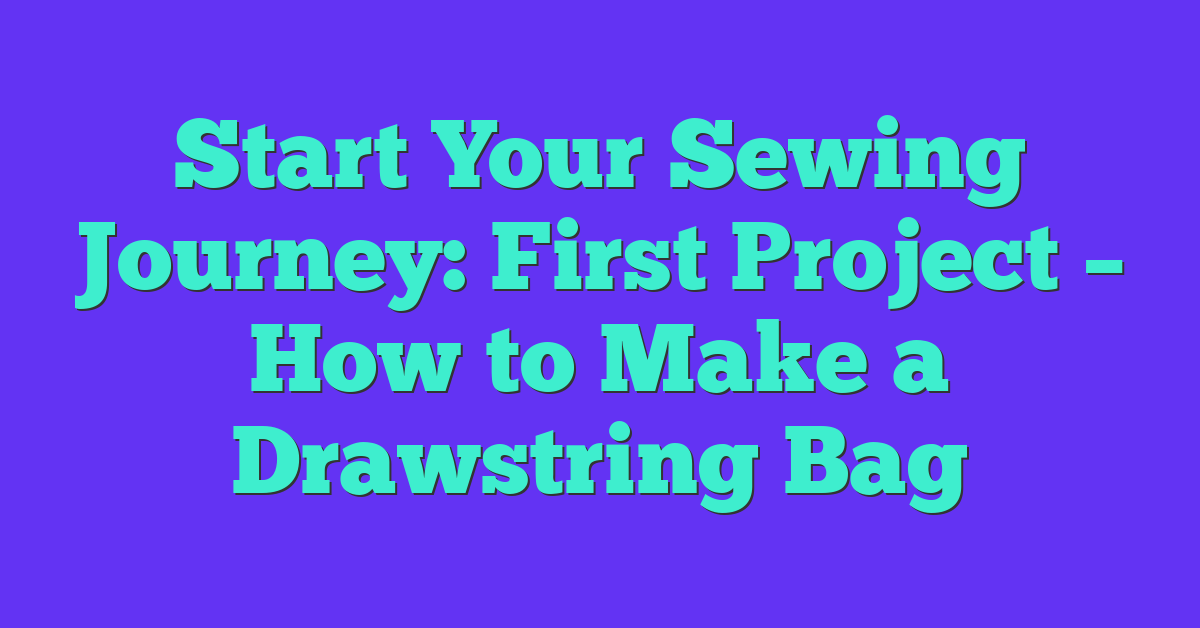I remember the excitement of picking up my first sewing machine and imagining all the possibilities. Making a drawstring bag is the perfect beginner’s project—it’s simple yet incredibly rewarding. Not only will you create something practical, but you’ll also build confidence in your sewing skills.
With just a few fabrics and some basic tools, you can craft a stylish bag that’s uniquely yours. I’ll guide you through each step, ensuring the process is easy to follow. Whether you’re new to sewing or looking to try something fresh, making a drawstring bag is a fun way to start your sewing journey.
Materials Needed
| Material | Quantity | Example |
|---|---|---|
| Fabric | 1 yard | Cotton, linen, or your choice |
| Thread | 1 spool | Matching color |
| Drawstring | 2 yards | Cord, ribbon, or shoelace |
| Scissors | 1 pair | Fabric scissors preferred |
| Measuring Tape | 1 | At least 60 inches long |
| Pins or Clips | 10-20 | To hold fabric pieces |
| Sewing Machine | 1 | Optional but recommended |
| Iron and Ironing Board | 1 set | To press seams |
Step-By-Step Instructions
Follow these steps to make your first drawstring bag with ease. Each stage builds your sewing skills effectively.
Cutting the Fabric
Measure 14×20 inches on your fabric using a measuring tape. Mark the dimensions with fabric chalk for precision. Cut two pieces for the exterior and two for the lining using sharp scissors and rotary cutters. Double-check measurements to ensure uniformity across all pieces.
Sewing the Sides
Align the exterior fabric pieces, right sides facing each other. Repeat with the lining pieces. Pin the sides and bottom edges using sewing pins or clips. Sew along the pinned edges with a 0.5-inch seam allowance using a sewing machine. Backstitch at the beginning and end to reinforce the seams. Press the seams flat with an iron for a professional look.
Creating the Drawstring
Fold the top edge of the exterior fabric inward by 1 inch and press. Do the same with the lining fabric, ensuring both are evenly folded. Sew around the folded edge, leaving a 2-inch gap for the drawstring to pass through. Attach a safety pin to one end of the drawstring and guide it through the channel using the pin. Once the drawstring is completely threaded, tie the ends securely. Trim any excess fabric and drawstring for a neat finish.
Essential Sewing Tips
- Select appropriate fabric: Choose sturdy materials like 100% cotton or canvas because they provide durability and hold shape well.
- Measure accurately: Use a measuring tape to ensure each fabric piece measures exactly 14×20 inches, guaranteeing a uniform bag size.
- Maintain seam allowance: Sew with a consistent 0.5-inch seam allowance to ensure strong, neat seams throughout the bag.
- Press seams frequently: Use an iron to press seams flat after sewing because it enhances the professional appearance and durability of the bag.
- Thread your machine correctly: Ensure proper threading of your sewing machine before starting to prevent jams and ensure smooth stitching.
- Pin securely: Use pins or clips to hold fabric pieces together tightly because secure pinning prevents shifting during sewing.
- Create a smooth drawstring channel: Fold and sew the top edges carefully to form an even channel for the drawstring, allowing it to move freely.
- Reinforce stress points: Double-stitch corners and areas under strain because reinforcement adds extra strength where the bag is most likely to wear.
- Trim excess threads: Cut any loose threads after sewing to give your drawstring bag a clean, polished finish.
- Test the drawstring: Pull the drawstring through the channel to ensure it operates smoothly and adjust if necessary for optimal functionality.
Customization Ideas
Fabric Selection
Choose fabrics in various colors, patterns, or textures. Mixing prints adds visual interest, while solid colors ensure versatility.
Embellishments
Add embroidery, appliqués, or patches. Personalize the bag with initials or decorative designs.
Drawstring Options
Use contrasting or braided cords. Select materials like ribbon, grosgrain, or cotton for different looks and durability.
Functional Additions
Incorporate pockets or zippers. External pockets provide extra storage, and zippers secure the bag’s contents.
Size Variations
Create different sizes for specific uses. Smaller bags suit cosmetics, while larger ones handle everyday essentials.
Closure Styles
Experiment with different closure methods. Toggle buttons or magnetic snaps offer alternatives to traditional drawstrings.
Reinforced Straps
Strengthen straps with double stitching or additional fabric layers. Ensure durability for carrying heavier items.
Color Blocking
Combine multiple colors in blocks or panels. This technique enhances the bag’s aesthetic appeal and customization.

Pattern Mixing
Integrate various patterns for a unique design. Stripes, polka dots, and floral prints can coexist harmoniously.
Personal Messages
Add quotes or messages using fabric paint or iron-on letters. Make the bag uniquely yours with meaningful text.
Conclusion
Starting my sewing journey with a drawstring bag was such a rewarding experience. Seeing the bag come together piece by piece boosted my confidence and made me eager to tackle more projects. I love how versatile this simple accessory can be, and the customization options are endless. Whether you’re using it for everyday essentials or as a stylish accessory, there’s something special about creating something with your own hands. If you’re thinking about trying sewing, I encourage you to dive in and enjoy the process. You’ll be surprised at how much you can create and the joy it brings. Happy sewing!

















